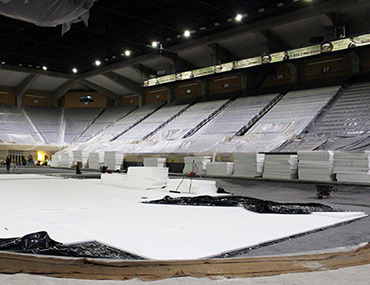INDUSTRIES SERVED BY FORTE EPS SOLUTIONS

 Industries Service by Forte EPS Manufacturers
Industries Service by Forte EPS Manufacturers
Expanded Polystyrene, commonly known as EPS foam in North America, is a lightweight, closed-cell, semi-rigid and highly insulating cellular plastic based material. Comprised mostly air, EPS foam exhibits physical and mechanical properties rendering it an excellent choice of material for numerous industries and applications, especially for insulation in construction projects, protective insulating packaging for food and general packaging products offering high impact protection for sensitive contents.
Expanded Polystyrene is the perfect solution for a broad range of industries including:
![]() Construction
Construction
![]() Public Infrastructure (roads, bridges, etc.)
Public Infrastructure (roads, bridges, etc.)
![]() Television & Film
Television & Film
![]() Automotive
Automotive
![]() OEM (Original Equipment Manufacturers)
OEM (Original Equipment Manufacturers)
 What is EPS Foam or Expanded Polystyrene?
What is EPS Foam or Expanded Polystyrene?
Expanded Polystyrene, commonly known as EPS in North America, is a light weight, closed-cell, semi-rigid cellular plastic material. EPS exhibits physical and mechanical properties which render it as an excellent choice of material for several industries and applications.
Main Physical and Mechanical Characteristics of EPS FOAM
Expanded Polystyrene has many desirable physical and mechanical properties such as:
![]() Superior long term thermal resistance
Superior long term thermal resistance
![]() EPS is an inert material and is dimensionally stable
EPS is an inert material and is dimensionally stable
![]() Excellent Buoyancy
Excellent Buoyancy
![]() Excellent moisture resistance
Excellent moisture resistance
![]() Light weight and easy to handle
Light weight and easy to handle
![]() High compressive strength relative to its weight
High compressive strength relative to its weight
![]() Versatile material and can be molded or cut into a multitude of shapes and forms
Versatile material and can be molded or cut into a multitude of shapes and forms
![]() 100% recyclable
100% recyclable
![]() Ozone friendly. Does not use CFC’s or HCFC’s in the manufacturing process
Ozone friendly. Does not use CFC’s or HCFC’s in the manufacturing process
![]() Cost effective with a relatively Low cost per R-value (R-value is a measure thermal insulation)
Cost effective with a relatively Low cost per R-value (R-value is a measure thermal insulation)
Applications of EPS FOAM for specific industries
Construction
The majority of EPS production in North America is used in the construction industry in several applications including:
![]() High density EPS insulation panel products
High density EPS insulation panel products
![]() Thermal insulating material for exterior/interior below and above grade walls and roof structures
Thermal insulating material for exterior/interior below and above grade walls and roof structures
![]() Thermal insulating material of floors and slab on grade
Thermal insulating material of floors and slab on grade
![]() Main substrate material for stucco and exterior insulating finishing systems (EIFS)
Main substrate material for stucco and exterior insulating finishing systems (EIFS)
![]() Thermal insulation for radiant floor heating
Thermal insulation for radiant floor heating
![]() Insulated concrete forms (ICF’s) for walls and floors
Insulated concrete forms (ICF’s) for walls and floors
![]() Structural insulated panels (SIP’s)
Structural insulated panels (SIP’s)
![]() Garage door insulation
Garage door insulation
Geofoam
Due to its light weight, dimensional stability and high compressive strength, a special grade of EPS referred to as geofoam is used in geotechnical applications including:
![]() Retaining wall backfill
Retaining wall backfill
![]() Road construction and widening
Road construction and widening
![]() Bridge abutment and underfill
Bridge abutment and underfill
![]() Culverts, pipelines and buried structures
Culverts, pipelines and buried structures
![]() Noise and vibration damping
Noise and vibration damping
![]() Slope stabilization
Slope stabilization
![]() Stadium and theatre seating
Stadium and theatre seating
![]() Under slab fill for ice rink floors
Under slab fill for ice rink floors
![]() Landscaping and green roofs
Landscaping and green roofs
Automotive
The automotive industry is another innovative application of EPS products. Automotive manufacturers have for the past decade increased their usage of EPS in the exterior and interior of several components to make cars and trucks lighter, more fuel efficient yet safe and stylish to attract more revenue from clients. EPS is now commonly used in automotive components such as:
![]() Behind bumpers
Behind bumpers
![]() Body side moldings
Body side moldings
![]() Dashboards
Dashboards
![]() Under seat cushions
Under seat cushions
![]() Behind door trims and arm rests
Behind door trims and arm rests
Recreational Themes
EPS has also proved its cost effectiveness for recreational themes. Due to its light weight and production versatility, EPS is used in the recreation industry to create monuments, historical building replicas and decorations. EPS can be molded, hand carved or custom cut with precision to create almost any shape as required. Furthermore several EPS shapes can be glued together easily to form larger objects. The final shape is then painted and/or coated to create the required theme without resorting to the use of heavy materials such as stone or cement or expensive skilled labor such as master masons.
Lost Foam
EPS is also used to create complex and precision metal shapes using a special technique known as lost foam casting. This process requires making the required metal shape in EPS. The EPS shape is then coated with refractory coating and placed in a casting flask that is filled with compacted sand. Molten material is then poured into the casting flask causing the EPS to vaporize leaving behind the required shape in precision cast metal. This is a cost effective method of creative precision metal shapes compared to the traditional wax casting.
